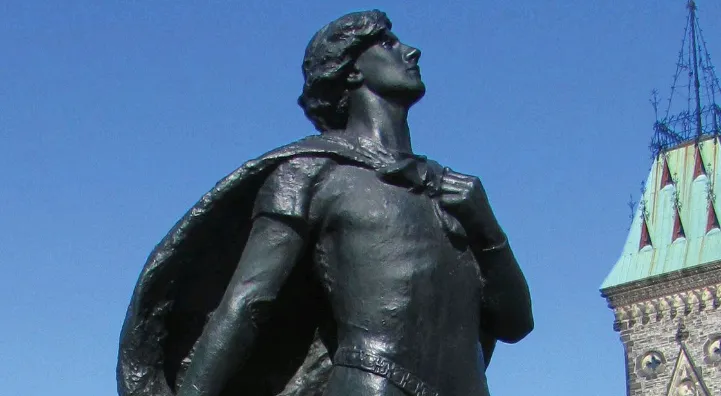Mysteries of the world → The Legend of Sir Galahad and the Quest for the Holy Grail: A Comprehensive Analysis
The Legend of Sir Galahad and the Quest for the Holy Grail: A Comprehensive Analysis
Introduction
Sir Galahad, a legendary knight of King Arthur's Round Table, is revered as the paragon of purity, virtue, and chivalry.
His name has become synonymous with the unwavering pursuit of the Holy Grail—the mystical vessel said to hold miraculous powers, including the ability to bestow eternal life and divine knowledge.
This article delves into the intricate tapestry of Galahad's tale by examining historical records, mythological interpretations, and cultural beliefs that have shaped the legend. By dissecting these elements, we aim to uncover the scientific, historical, and mythological roots that illuminate Galahad’s iconic quest for the Grail.
1. Historical and Literary Origins of Galahad
The story of Sir Galahad and the search for the Holy Grail is deeply entrenched in medieval literature, emerging from a confluence of Christian, Celtic, and pre-Christian mythologies.
To understand the legend in its entirety, it is crucial to trace the origins and evolution of both the figure of Galahad and the Holy Grail.
1.1 The Arthurian Legends and Medieval Sources
Sir Galahad's earliest detailed mention can be found in The Vulgate Cycle, also known as Lancelot-Grail, a 13th-century series of French prose texts attributed to multiple authors.
The cycle integrates the chivalric exploits of King Arthur and his knights with a strong Christian theme that pervades their quests. Galahad is introduced as the illegitimate son of Sir Lancelot and Lady Elaine of Corbenic, his birth orchestrated by divine prophecy.
The quest for the Holy Grail itself can be traced back to older Celtic legends involving cauldrons imbued with magical properties. These cauldrons, which could provide endless sustenance or resurrect the dead, prefigure the Christianized Grail with its association to the Last Supper and the crucifixion of Christ.
The transition from these older, more pagan ideas to Christianized symbolism represents a fusion of pre-existing mythologies adapted to fit a religious framework that resonated with medieval European audiences.
1.2 The Influence of Religious Themes
The rise of Galahad as the paramount knight is not coincidental; his story intertwines seamlessly with Christian teachings of purity and divine purpose.
The depiction of...
Introduction
Sir Galahad, a legendary knight of King Arthur's Round Table, is revered as the paragon of purity, virtue, and chivalry.
His name has become synonymous with the unwavering pursuit of the Holy Grail—the mystical vessel said to hold miraculous powers, including the ability to bestow eternal life and divine knowledge.
This article delves into the intricate tapestry of Galahad's tale by examining historical records, mythological interpretations, and cultural beliefs that have shaped the legend. By dissecting these elements, we aim to uncover the scientific, historical, and mythological roots that illuminate Galahad’s iconic quest for the Grail.
1. Historical and Literary Origins of Galahad
The story of Sir Galahad and the search for the Holy Grail is deeply entrenched in medieval literature, emerging from a confluence of Christian, Celtic, and pre-Christian mythologies.
To understand the legend in its entirety, it is crucial to trace the origins and evolution of both the figure of Galahad and the Holy Grail.
1.1 The Arthurian Legends and Medieval Sources
Sir Galahad's earliest detailed mention can be found in The Vulgate Cycle, also known as Lancelot-Grail, a 13th-century series of French prose texts attributed to multiple authors.
The cycle integrates the chivalric exploits of King Arthur and his knights with a strong Christian theme that pervades their quests. Galahad is introduced as the illegitimate son of Sir Lancelot and Lady Elaine of Corbenic, his birth orchestrated by divine prophecy.
The quest for the Holy Grail itself can be traced back to older Celtic legends involving cauldrons imbued with magical properties. These cauldrons, which could provide endless sustenance or resurrect the dead, prefigure the Christianized Grail with its association to the Last Supper and the crucifixion of Christ.
The transition from these older, more pagan ideas to Christianized symbolism represents a fusion of pre-existing mythologies adapted to fit a religious framework that resonated with medieval European audiences.
1.2 The Influence of Religious Themes
The rise of Galahad as the paramount knight is not coincidental; his story intertwines seamlessly with Christian teachings of purity and divine purpose.
The depiction of...



